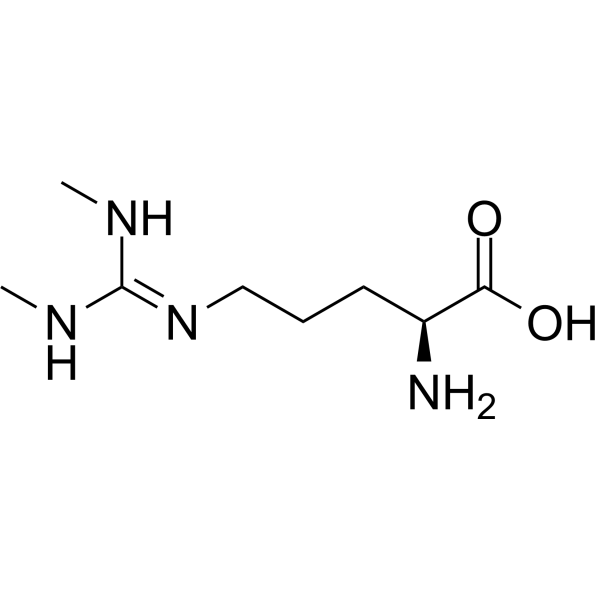
| 规格 | 价格 | |
|---|---|---|
| 500mg | ||
| 1g | ||
| Other Sizes |
| 体外研究 (In Vitro) |
作为肾功能的内源性指标,SDMA是心血管危险因素不对称二甲基精氨酸的结构异构体。 SDMA 是精氨酸转运的竞争对手,但不直接阻断 NOS。 SDMA 是一种很有前景的肾小球滤过率内源性指标,主要由肾脏排泄[1]。虽然 SDMA 对 NOS 的蛋白表达没有影响,但它会剂量依赖性地抑制完整内皮细胞中 NO 的产生 [1]。通过激活 NF-κB 以及随后上调 IL-6 和 TNF-α 的产生,SDMA 有助于与慢性肾脏病相关的炎症过程 [2]。
|
|---|---|
| 体内研究 (In Vivo) |
SDMA 的血清和血浆样品都表现出良好的稳定性,并且该测定的分析性能非常好。虽然 SDMA 在未受影响的狗中保持恒定,但在患病狗中,随着疾病的进展,SDMA 会增加,并且与 sCr 的增加和 GFR 的降低密切相关 [3]。四周后,接受长期 SDMA 输注的小鼠显示 SDMA 水平大幅上升,但 GFR 没有变化。没有观察到组织学改变,特别是在纤维化或内皮细胞中一氧化氮合酶的表达方面。收缩压和射血分数不受 SDMA 影响 [4]。
|
| 药代性质 (ADME/PK) |
Metabolism / Metabolites
Uremic toxins tend to accumulate in the blood either through dietary excess or through poor filtration by the kidneys. Most uremic toxins are metabolic waste products and are normally excreted in the urine or feces. |
| 毒性/毒理 (Toxicokinetics/TK) |
Toxicity Summary
Uremic toxins such as symmetric dimethylarginine are actively transported into the kidneys via organic ion transporters (especially OAT3). Increased levels of uremic toxins can stimulate the production of reactive oxygen species. This seems to be mediated by the direct binding or inhibition by uremic toxins of the enzyme NADPH oxidase (especially NOX4 which is abundant in the kidneys and heart) (A7868). Reactive oxygen species can induce several different DNA methyltransferases (DNMTs) which are involved in the silencing of a protein known as KLOTHO. KLOTHO has been identified as having important roles in anti-aging, mineral metabolism, and vitamin D metabolism. A number of studies have indicated that KLOTHO mRNA and protein levels are reduced during acute or chronic kidney diseases in response to high local levels of reactive oxygen species (A7869). |
| 参考文献 |
|
| 其他信息 |
N(omega),N'(omega)-dimethyl-L-arginine is a L-arginine derivative having two methyl groups at the N(omega)- and N'(omega)-positions It has a role as an EC 1.14.13.39 (nitric oxide synthase) inhibitor. It is a member of guanidines, a non-proteinogenic L-alpha-amino acid, a L-arginine derivative and a dimethylarginine. It is a conjugate base of a N(omega),N('omega)-dimethyl-L-argininium(1+). It is a tautomer of a N(omega),N'(omega)-dimethyl-L-arginine zwitterion.
Symmetric Dimethylarginine is a dimethylated derivative of L-arginine where the two methyl groups are attached to arginine in a symmetrical configuration. Symmetric dimethylarginine (SDMA) is formed when S-adenosylmethionine protein N-methyltransferases transfer one methyl group from S-adenosylmethionine to each of the two guanidine nitrogen groups of a single arginine residue in a protein. SDMA is released when the protein is degraded. SDMA doesn't bind nitric oxide synthase (NOS) but may noncompetitivelty inhibit nitric oxide (NO) synthesis by reducing L-arginine availability; it also may play a role in the modulation of cardiovascular homeostasis and renal function. Symmetric dimethylarginine is a uremic toxin. Uremic toxins can be subdivided into three major groups based upon their chemical and physical characteristics: 1) small, water-soluble, non-protein-bound compounds, such as urea; 2) small, lipid-soluble and/or protein-bound compounds, such as the phenols and 3) larger so-called middle-molecules, such as beta2-microglobulin. Chronic exposure of uremic toxins can lead to a number of conditions including renal damage, chronic kidney disease and cardiovascular disease. Symmetric dimethylarginine (SDMA) is an endogenously produced inhibitor of nitric oxide synthase (EC-Number 1.14.13.39). However, elevated levels of SDMA occur in patients with vascular disease, especially suffering end-stage renal disease. (A3290). |
| 分子式 |
C8H18N4O2
|
|---|---|
| 分子量 |
202.25412
|
| 精确质量 |
202.143
|
| CAS号 |
30344-00-4
|
| PubChem CID |
169148
|
| 外观&性状 |
White to off-white solid powder
|
| 密度 |
1.22g/cm3
|
| 沸点 |
367.7ºC at 760mmHg
|
| 闪点 |
176.2ºC
|
| 折射率 |
1.54
|
| LogP |
0.455
|
| tPSA |
99.74
|
| 氢键供体(HBD)数目 |
4
|
| 氢键受体(HBA)数目 |
4
|
| 可旋转键数目(RBC) |
7
|
| 重原子数目 |
14
|
| 分子复杂度/Complexity |
206
|
| 定义原子立体中心数目 |
1
|
| SMILES |
N[C@@H](CCCN/C(NC)=N/C)C(O)=O
|
| InChi Key |
HVPFXCBJHIIJGS-LURJTMIESA-N
|
| InChi Code |
InChI=1S/C8H18N4O2/c1-10-8(11-2)12-5-3-4-6(9)7(13)14/h6H,3-5,9H2,1-2H3,(H,13,14)(H2,10,11,12)/t6-/m0/s1
|
| 化学名 |
(2S)-2-amino-5-[(N,N'-dimethylcarbamimidoyl)amino]pentanoic acid
|
| HS Tariff Code |
2934.99.9001
|
| 存储方式 |
Powder -20°C 3 years 4°C 2 years In solvent -80°C 6 months -20°C 1 month |
| 运输条件 |
Room temperature (This product is stable at ambient temperature for a few days during ordinary shipping and time spent in Customs)
|
| 溶解度 (体外实验) |
DMSO : ~67.5 mg/mL (~333.75 mM)
H2O : ~50 mg/mL (~247.22 mM) |
|---|---|
| 溶解度 (体内实验) |
配方 1 中的溶解度: ≥ 2.5 mg/mL (12.36 mM) (饱和度未知) in 10% DMSO + 40% PEG300 + 5% Tween80 + 45% Saline (这些助溶剂从左到右依次添加,逐一添加), 澄清溶液。
例如,若需制备1 mL的工作液,可将100 μL 25.0 mg/mL澄清DMSO储备液加入到400 μL PEG300中,混匀;然后向上述溶液中加入50 μL Tween-80,混匀;加入450 μL生理盐水定容至1 mL。 *生理盐水的制备:将 0.9 g 氯化钠溶解在 100 mL ddH₂O中,得到澄清溶液。 配方 2 中的溶解度: ≥ 2.5 mg/mL (12.36 mM) (饱和度未知) in 10% DMSO + 90% (20% SBE-β-CD in Saline) (这些助溶剂从左到右依次添加,逐一添加), 澄清溶液。 例如,若需制备1 mL的工作液,可将 100 μL 25.0 mg/mL澄清DMSO储备液加入900 μL 20% SBE-β-CD生理盐水溶液中,混匀。 *生理盐水的制备:将 0.9 g 氯化钠溶解在 100 mL ddH₂O中,得到澄清溶液。 View More
配方 3 中的溶解度: 2.5 mg/mL (12.36 mM) in 10% DMSO + 90% Corn Oil (这些助溶剂从左到右依次添加,逐一添加), 悬浊液; 超声助溶。 配方 4 中的溶解度: 120 mg/mL (593.33 mM) in PBS (这些助溶剂从左到右依次添加,逐一添加), 澄清溶液; 超声助溶. 1、请先配制澄清的储备液(如:用DMSO配置50 或 100 mg/mL母液(储备液)); 2、取适量母液,按从左到右的顺序依次添加助溶剂,澄清后再加入下一助溶剂。以 下列配方为例说明 (注意此配方只用于说明,并不一定代表此产品 的实际溶解配方): 10% DMSO → 40% PEG300 → 5% Tween-80 → 45% ddH2O (或 saline); 假设最终工作液的体积为 1 mL, 浓度为5 mg/mL: 取 100 μL 50 mg/mL 的澄清 DMSO 储备液加到 400 μL PEG300 中,混合均匀/澄清;向上述体系中加入50 μL Tween-80,混合均匀/澄清;然后继续加入450 μL ddH2O (或 saline)定容至 1 mL; 3、溶剂前显示的百分比是指该溶剂在最终溶液/工作液中的体积所占比例; 4、 如产品在配制过程中出现沉淀/析出,可通过加热(≤50℃)或超声的方式助溶; 5、为保证最佳实验结果,工作液请现配现用! 6、如不确定怎么将母液配置成体内动物实验的工作液,请查看说明书或联系我们; 7、 以上所有助溶剂都可在 Invivochem.cn网站购买。 |
| 制备储备液 | 1 mg | 5 mg | 10 mg | |
| 1 mM | 4.9444 mL | 24.7219 mL | 49.4438 mL | |
| 5 mM | 0.9889 mL | 4.9444 mL | 9.8888 mL | |
| 10 mM | 0.4944 mL | 2.4722 mL | 4.9444 mL |
1、根据实验需要选择合适的溶剂配制储备液 (母液):对于大多数产品,InvivoChem推荐用DMSO配置母液 (比如:5、10、20mM或者10、20、50 mg/mL浓度),个别水溶性高的产品可直接溶于水。产品在DMSO 、水或其他溶剂中的具体溶解度详见上”溶解度 (体外)”部分;
2、如果您找不到您想要的溶解度信息,或者很难将产品溶解在溶液中,请联系我们;
3、建议使用下列计算器进行相关计算(摩尔浓度计算器、稀释计算器、分子量计算器、重组计算器等);
4、母液配好之后,将其分装到常规用量,并储存在-20°C或-80°C,尽量减少反复冻融循环。
计算结果:
工作液浓度: mg/mL;
DMSO母液配制方法: mg 药物溶于 μL DMSO溶液(母液浓度 mg/mL)。如该浓度超过该批次药物DMSO溶解度,请首先与我们联系。
体内配方配制方法:取 μL DMSO母液,加入 μL PEG300,混匀澄清后加入μL Tween 80,混匀澄清后加入 μL ddH2O,混匀澄清。
(1) 请确保溶液澄清之后,再加入下一种溶剂 (助溶剂) 。可利用涡旋、超声或水浴加热等方法助溶;
(2) 一定要按顺序加入溶剂 (助溶剂) 。